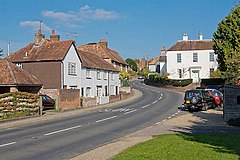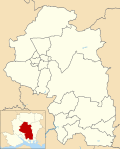Droxford
| Droxford | |
|---|---|
 High Street | |
 The local church is medieval and dedicated to All Saints and St Mary | |
Location withinHampshire | |
| Population | 600[1] 675 (2011 Census)[2] |
| OS grid reference | SU 60738 18662 |
| District | |
| Shire county | |
| Region | |
| Country | England |
| Sovereign state | United Kingdom |
| Post town | SOUTHAMPTON |
| Postcode district | SO32 |
| Dialling code | 01489 |
| Police | Hampshire and Isle of Wight |
| Fire | Hampshire and Isle of Wight |
| Ambulance | South Central |
| UK Parliament | |
Droxford(arch.Drokensford) is a village inHampshire,England.
Geography
[edit]The village isclusteredwith slightribbon developmentalong its main, north–south, undulating road. It is entirely on the lower half of the western slopes of theMeonvalley. Farms and residential outbuildings stretch to the west, north and south. It is centred aroundthe Church of St Mary and All Saints,a mainly 13th- and 14th-century church with a 1599-built tower, togetherlisted in the highest category for heritage.[3]Next to the church is the old rectory dating from the 18th century.[4]The village is 3.5 miles (5.6 km) east of the nearest townBishop's Waltham.
It is toward the centre-west of theSouth Downs National Parkwhich was upgraded and expanded from a smallerAONBwithin which it sat in 2011. The non-dualled, non-trunkA32passes through the village betweenGosportandAltonwhich is largely bypassed by two motorways in the national network known as the A3 and M3. The formerMeon Valley Railwayhas been converted into a lengthy footpath running fromWest Meonto Knowle Junction and the railway station converted to a house, a short walk across the water meadows from the village.
Amenities
[edit]The village has a convergence of national long-distance footpaths, a number of holiday lets and bed-and-breakfast establishments, apost office,a refuelling garage, onepuband a village hall. Neighbouring isolatedShirrell Heathcommands a view of the Hamble and Meon valleys, with the often "blue" hills of the Isle of Wight on the horizon.[5]
History
[edit]During the late 5th and early 6th centuries, theJutesinhabited theMeon Valley,and at Droxford there is the remains of a large Jutish cemetery that has produced various grave goods, providing evidence of their settlement.[6][7]
The Manor ofDrocenesforda(Droxford) was granted to thePriorandmonksofSt. Swithun,Winchester,byKing Egbertin 826. In 939 kingÆthelstangranted 17hides of landat Droxford to his half-sisterEadburh.[8]By the time of theDomesday SurveyDroxford which included much ofSwanmore(the name of one of itstythings) and Shedfield[5]had passed to theBishop of Winchester,to support the monks. This arrangement continued until 1551 when it was surrendered to the crown. It was passed on to theEarl of Wiltshire.
The Bishopric regained themanorin 1558, holding it until theCivil War.During the rule of Parliament the manor was transferred into private hands but on theRestorationofKing Charles IIin 1660 it was restored to the Bishopric.[5]
This situation continued until 1869 when the manor (amounting to a lessened, mid-19th-century, wealth and control of land management in the parish) was removed from the Bishopric as part of the Bishops' Resignation Act of 1869, and the area of the parish glebe (church lands) had also been substantially reduced by this time.[5]A Primitive Methodist church or chapel was built in 1886.
A railway came to serve Droxford in 1903 across the river in the neighbouring more rural parish with the building of theMeon Valley Railway.Droxford railway stationwas built to the north east of the village and settlement grew around the station including a hotel, railway workers' cottages and a cluster of private homes. These extended to the north to the Brock Bridge or Brockbridge farm and mill which retains its name.
In June 1944 Allied leaders includingWinston Churchill,Dwight Eisenhower,andCharles de Gaullemet in a railway carriage atDroxford railway stationto discuss the imminent D-Day invasion. There is a bench in the village to commemorate this meeting of world leaders in Droxford.British Railwaysclosed the railway to passengers in 1955, and freight in 1962. After being used for testing and storage purposes it was finally removed in the 1970s.[9]
Church and landowner poverty relief
[edit]Aside from its state-incepted poor rate relief, the parish had minor legacies since the late 17th century and medium legacies relative to its small population since the 1850s for its poorest residents.
John Arthur, by will 1722, endowed for the poor of "the tithings of Droxford and Hill" £30; John Dee, by will 1749, gave for the local poor £50 (equivalent to £10,000 in 2023); and the Rev. James Cutler, formerly rector of the parish, by will 1782, left £50. These sums, with accumulated interest, were laid out in the purchase of £215+1⁄20"consols" (consolidated investments), by 1905 held by the official trustees, the dividends, amounting to £5+11⁄30a year being applied with the similar-size Boucher charity.[5]
In 1850 James George Boucher, by will, bequeathed to the rector and churchwardens a sum by 1905 growing to £190 18s. 7d. consols, with the official trustees, for the benefit of the poor of the parish. The dividends, amounting to £4+23⁄30.[5]
These dividends were for example in 1905 distributed thus: to the vicar of Shedfield £4..., to the vicar of Swanmore £3..., to be distributed in those districts, and £2 13s. 6d. was given in money to ten poor people in Droxford (i.e. £2+27⁄40,equivalent to £360 in 2023).[5]
By Inclosure Award of 9 May 1855, two allotments of 4 acres each were allotted for the use of the poor of Shedfield, the rents of which, amounting to about £25 a year, were still in 1905 applied for public uses, subject, however, to yearly rent-charges. Under the same award 5 acres was allotted as a recreation ground. By deed of 1880 a site and buildings were given at minimal value for the purpose of reading and recreation rooms.[5]
References
[edit]- ^"Census data".Archived fromthe originalon 17 July 2012.Retrieved25 June2010.
- ^"Civil Parish population 2011".Neighbourhood Statistics.Office for National Statistics.Retrieved14 December2016.
- ^Historic England."Details from listed building database (1095540)".National Heritage List for England.
- ^O’Brien, Charles; Bailey, Bruce; Pevsner, Nikolaus; Lloyd, David W. (2018).The Buildings of England Hampshire: South.Yale University Press. pp. 240–243.ISBN9780300225037.
- ^abcdefgh"Parishes: Droxford | British History Online".
- ^Turner, Barbara Carpenter (1978).A History of Hampshire.Chichester: Phillimore. p. 24.ISBN0-85033-254-0.
- ^Smith, L. (2009). G.E.Jeans (ed.).Memorials of Old Hampshire: The Jutish Settlements of the Meon Valley.London: BiblioBazaar. p. 39.ISBN978-1-113-82344-1.
- ^Sawyer no. 446
- ^Buttrey, Pam (2012).A History Of Droxford Station.Southampton: Noodle Books. p. 12.ISBN978-1906419936.
External links
[edit]



